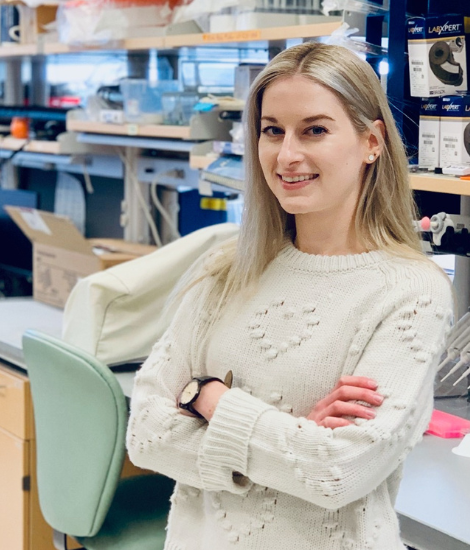My PD Story

Briana De Miranda, PhD
2018 Postdoctoral Fellowship
2023 Stanley Fahn Junior Faculty Award
Connecting Environmental Exposures and Parkinson's Disease Through Accelerated Brain Aging
The greatest risk factor for Parkinson’s disease (PD) is aging, but the disease varies among affected individuals of similar ages. This implies that external factors, such as exposure to environmental toxicants, likely play a role in PD progression that coincides with the aging process. A wide range of research has been done correlating pesticide exposure to PD incidence, but the cellular processes involved in such a connection have been difficult to fully untangle. Briana De Miranda, PhD, recipient of a Parkinson’s Foundation Stanley Fahn Junior Faculty Award, will seek to better understand what happens in cells after exposure to PD-related toxicants and how that may lead to accelerated cellular aging and impact PD risk and progression.
As certain specialized cells like microglia and astrocytes age, they eventually reach a stage called senescence, when they no longer function efficiently and begin causing residual damage to neighboring cells and tissues. Elevated levels of senescence markers have been found in postmortem brain tissue of people with PD, suggesting that accelerated brain aging may be associated with PD. Previous research conducted by Dr. De Miranda and her lab at the University of Alabama at Birmingham has shown that environmental toxicants (such as pesticides, organic solvents and heavy metals): 1) are correlated with an increased risk of PD, and 2) trigger increased levels of the senescence marker p16 in glial cells near degenerating dopaminergic neurons.
To further unravel how environmental toxicants impact cell senescence in the brain and PD pathology, Dr. De Miranda will first use mice that have been genetically engineered to allow her to visualize and measure p16 expression across the brain. After exposing these mice to environmental toxicants associated with elevated PD risk, she will map which cell types and regions in the brain are most vulnerable to becoming senescent after each exposure.
Next, Dr. De Miranda will see if selectively eliminating senescent neurons has a protective effect on the rest of the brain, slowing or preventing PD-like neurodegeneration from toxicant exposure. She will use mice genetically engineered to have neurons with “self-destruct” switches that trigger when they become senescent and start producing p16. By having senescent neurons clear themselves out automatically, Dr. De Miranda hopes to see if their absence reduces damage to surrounding neurons. If successful, this research could spark new PD therapies centered on senescent cell remediation to combat disease progression.
Unlike the senescent cells, Dr. De Miranda has no plans of slowing down and is energized by her Stanley Fahn Junior Faculty Award: “The research funded by this award will show how our environment influences the rate by which we age, potentially opening new doors for therapeutic treatments or strategies to prevent exposure, aging and PD… I am grateful for the continued support from the Parkinson's Foundation to understand how the environment
influences PD risk, an important but understudied topic in PD research.”
Meet more Parkinson’s researchers! Explore our My PD Stories featuring PD researchers.
Related Materials
More Stories
from the Parkinson's community


